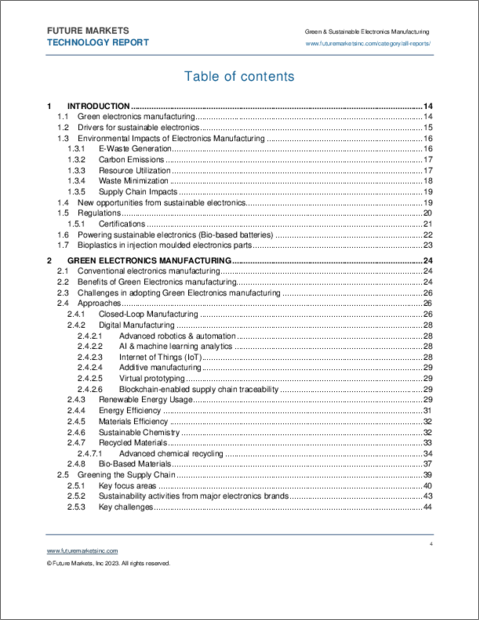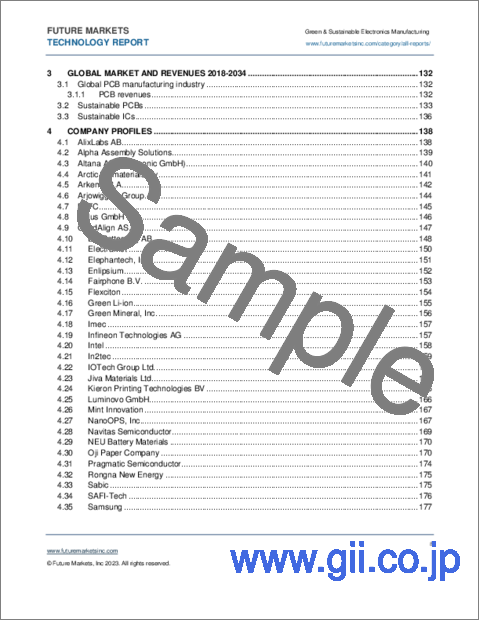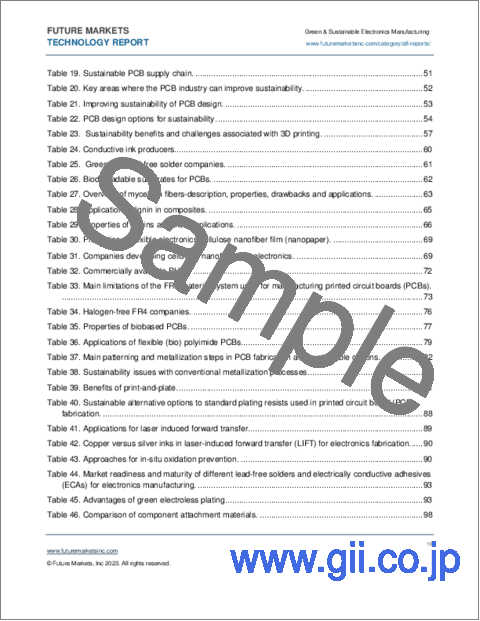|
|
市場調査レポート
商品コード
1348024
グリーン・サステナブルエレクトロニクス製造の世界市場(2024年~2034年)The Global Market for Green and Sustainable Electronics Manufacturing 2024-2034 |
||||||
|
|||||||
| グリーン・サステナブルエレクトロニクス製造の世界市場(2024年~2034年) |
|
出版日: 2023年09月25日
発行: Future Markets, Inc.
ページ情報: 英文 205 Pages, 65 Tables, 46 Figures
納期: 即納可能
|
- 全表示
- 概要
- 図表
- 目次
電子産業は過去数十年にわたって大きな成長を示し、電子機器は現代生活に欠かせないものとなっています。しかし、この成長は、高いエネルギー消費、資源の枯渇、電子廃棄物(e-waste)など、環境への重大な影響にもつながっています。国連によると、電子廃棄物は世界中でもっとも急速に増加しており、もっとも危険な廃棄物の流れとなっています。このため、エレクトロニクス製造をより持続可能で環境に優しいものにする必要性が高まり、電子産業の環境フットプリントを削減するアプローチとして「グリーンエレクトロニクス」の台頭につながっています。
持続可能なPCB設計の開発は、グリーン製造の推進の一部として近年成長しています。従来のPCB製造は、環境に有害な銅、エポキシ樹脂、ガラス繊維、水を使用する、エネルギー集約的で排出の多いプロセスに依存しています。リサイクル技術は効率が低く、手間のかかる工程を含んでいます。
リサイクルしやすい新材料が利用され、PCB製造には生分解性ポリマーや紙のPCBが使われています。既存のサブトラクティブ法や、インクジェット/レーザー印刷のようなアディティブマニュファクチャリング向けの環境に優しいエッチャントの利用も増えています。アディティブ法を採用することで、製造時のエネルギー消費は従来の5分の1にまで抑えることができます。さまざまなセルロースや木質系材料、バイオプラスチック、バイオ複合材料など、持続可能で印刷可能な基板材料が開発されています。
当レポートでは、世界のグリーン・サステナブルエレクトロニクス製造市場について調査分析し、PCB、IC、電池、組立、電子機器のサプライチェーンにおける産業動向、促進要因、課題、アプローチ、技術、材料、プロセス、主要企業などの情報を提供しています。
目次
第1章 イントロダクション
- グリーンエレクトロニクス製造
- サステナブルエレクトロニクスの促進要因
- エレクトロニクス製造の環境に対する影響
- 電子廃棄物の生成
- 炭素排出
- リソースの活用
- 廃棄物の最小化
- サプライチェーンに対する影響
- サステナブルエレクトロニクスによる新たな機会
- 規則
- 認証
- サステナブルエレクトロニクスへの電力供給(バイオベース電池)
- 射出成形電子部品におけるバイオプラスチック
第2章 グリーンエレクトロニクス製造
- 従来のエレクトロニクス製造
- グリーンエレクトロニクス製造の利点
- グリーンエレクトロニクス製造の採用における課題
- アプローチ
- クローズドループ製造
- デジタルマニュファクチャリング
- 再生可能エネルギーの利用
- エネルギー効率
- 材料効率
- サステナブルケミストリー
- 再利用材料
- バイオベース材料
- サプライチェーンのグリーン化
- 重点分野
- 主要エレクトロニクスブランドによるサステナビリティ活動
- 主な課題
- デジタル技術の活用
- 持続可能なPCB製造
- 従来のPCB製造
- PCBの動向
- 持続可能性とパフォーマンスの調和
- 持続可能なサプライチェーン
- PCB製造における持続可能性
- 持続可能性に向けたPCBの設計
- 材料
- 基板
- エレクトロニクス製造における持続可能なパターニングとメタライゼーション
- コンポーネントの持続可能な取り付けと統合
- 持続可能なIC
- IC製造
- 持続可能なIC製造
- ウエハー生産
- 酸化方法
- パターニング、ドーピング
- メタライゼーション
- EOL
- 有害廃棄物
- 排出
- 水の使用
- リサイクル
- グリーン認証
第3章 世界市場と収益(2018年~)
- 世界のPCB製造産業
- PCBの収益
- 持続可能なPCB
- 持続可能なIC
第4章 企業プロファイル(企業44社のプロファイル)
第5章 調査手法
第6章 参考材料
List of Tables
- Table 1. Key factors driving adoption of green electronics
- Table 2. Key circular economy strategies for electronics
- Table 3. Regulations pertaining to green electronics
- Table 4. Companies developing bio-based batteries for application in sustainable electronics
- Table 5. Benefits of Green Electronics Manufacturing
- Table 6. Challenges in adopting Green Electronics manufacturing
- Table 7. Major chipmakers' renewable energy road maps
- Table 8. Energy efficiency in sustainable electronics manufacturing
- Table 9. Composition of plastic waste streams
- Table 10. Comparison of mechanical and advanced chemical recycling
- Table 11. Example chemically recycled plastic products
- Table 12. Bio-based and non-toxic materials in sustainable electronics
- Table 13. Key focus areas for enabling greener and ethically responsible electronics supply chains
- Table 14. Sustainability programs and disclosure from major electronics brands
- Table 15. PCB manufacturing process
- Table 16. Challenges in PCB manufacturing
- Table 17. 3D PCB manufacturing
- Table 18. Comparison of some sustainable PCB alternatives against conventional options in terms of key performance factors
- Table 19. Sustainable PCB supply chain
- Table 20. Key areas where the PCB industry can improve sustainability
- Table 21. Improving sustainability of PCB design
- Table 22. PCB design options for sustainability
- Table 23. Sustainability benefits and challenges associated with 3D printing
- Table 24. Conductive ink producers
- Table 25. Green and lead-free solder companies
- Table 26. Biodegradable substrates for PCBs
- Table 27. Overview of mycelium fibers-description, properties, drawbacks and applications
- Table 28. Application of lignin in composites
- Table 29. Properties of lignins and their applications
- Table 30. Properties of flexible electronics-cellulose nanofiber film (nanopaper)
- Table 31. Companies developing cellulose nanofibers for electronics
- Table 32. Commercially available PHAs
- Table 33. Main limitations of the FR4 material system used for manufacturing printed circuit boards (PCBs)
- Table 34. Halogen-free FR4 companies
- Table 35. Properties of biobased PCBs
- Table 36. Applications of flexible (bio) polyimide PCBs
- Table 37. Main patterning and metallization steps in PCB fabrication and sustainable options
- Table 38. Sustainability issues with conventional metallization processes
- Table 39. Benefits of print-and-plate
- Table 40. Sustainable alternative options to standard plating resists used in printed circuit board (PCB) fabrication
- Table 41. Applications for laser induced forward transfer
- Table 42. Copper versus silver inks in laser-induced forward transfer (LIFT) for electronics fabrication
- Table 43. Approaches for in-situ oxidation prevention
- Table 44. Market readiness and maturity of different lead-free solders and electrically conductive adhesives (ECAs) for electronics manufacturing
- Table 45. Advantages of green electroless plating
- Table 46. Comparison of component attachment materials
- Table 47. Comparison between sustainable and conventional component attachment materials for printed circuit boards
- Table 48. Comparison between the SMAs and SMPs
- Table 49. Comparison of conductive biopolymers versus conventional materials for printed circuit board fabrication
- Table 50. Comparison of curing and reflow processes used for attaching components in electronics assembly
- Table 51. Low temperature solder alloys
- Table 52. Thermally sensitive substrate materials
- Table 53. Limitations of existing IC production
- Table 54. Strategies for improving sustainability in integrated circuit (IC) manufacturing
- Table 55. Comparison of oxidation methods and level of sustainability
- Table 56. Stage of commercialization for oxides
- Table 57. Alternative doping techniques
- Table 58. Metal content mg / Kg in Printed Circuit Boards (PCBs) from waste desktop computers
- Table 59. Chemical recycling methods for handling electronic waste
- Table 60. Electrochemical processes for recycling metals from electronic waste
- Table 61. Thermal recycling processes for electronic waste
- Table 62. Global PCB revenues 2018-2034 (billions USD), by substrate types
- Table 63. Global sustainable PCB revenues 2018-2034, by type (millions USD)
- Table 64. Global sustainable ICs revenues 2018-2034, by type (millions USD)
- Table 65. Oji Holdings CNF products
List of Figures
- Figure 1. Closed-loop manufacturing
- Figure 2. Sustainable supply chain for electronics
- Figure 3. Flexible PCB
- Figure 4. Vapor degreasing
- Figure 5. Multi-layered PCB
- Figure 6. 3D printed PCB
- Figure 7. In-mold electronics prototype devices and products
- Figure 8. Silver nanocomposite ink after sintering and resin bonding of discrete electronic components
- Figure 9. Typical structure of mycelium-based foam
- Figure 10. Flexible electronic substrate made from CNF
- Figure 11. CNF composite
- Figure 12. Oji CNF transparent sheets
- Figure 13. Electronic components using cellulose nanofibers as insulating materials
- Figure 14. BLOOM masterbatch from Algix
- Figure 15. Dell's Concept Luna laptop
- Figure 16. Direct-write, precision dispensing, and 3D printing platform for 3D printed electronics
- Figure 17. 3D printed circuit boards from Nano Dimension
- Figure 18. Photonic sintering
- Figure 19. Laser-induced forward transfer (LIFT)
- Figure 20. Material jetting 3d printing
- Figure 21. Material jetting 3d printing product
- Figure 22. The molecular mechanism of the shape memory effect under different stimuli
- Figure 23. Supercooled Soldering™ Technology
- Figure 24. Reflow soldering schematic
- Figure 25. Schematic diagram of induction heating reflow
- Figure 26. Fully-printed organic thin-film transistors and circuitry on one-micron-thick polymer films
- Figure 27. Types of PCBs after dismantling waste computers and monitors
- Figure 28. Global PCB revenues 2018-2034 (billions USD), by substrate types
- Figure 29. Global sustainable PCB revenues 2018-2034, by type (millions USD)
- Figure 30. Global sustainable ICs revenues 2018-2034, by type (millions USD)
- Figure 31. Piezotech® FC
- Figure 32. PowerCoat® paper
- Figure 33. BeFC® biofuel cell and digital platform
- Figure 34. DPP-360 machine
- Figure 35. P-Flex® Flexible Circuit
- Figure 36. Fairphone 4
- Figure 37. In2tec's fully recyclable flexible circuit board assembly
- Figure 38. C.L.A.D. system
- Figure 39. Soluboard immersed in water
- Figure 40. Infineon PCB before and after immersion
- Figure 41. Nano OPS Nanoscale wafer printing system
- Figure 42. Stora Enso lignin battery materials
- Figure 43. 3D printed electronics
- Figure 44. Tactotek IME device
- Figure 45. TactoTek® IMSE® SiP - System In Package
- Figure 46. Verde Bio-based resins
The electronics industry has witnessed massive growth over the past few decades, with electronic devices becoming an integral part of modern life. However, this growth has also led to significant environmental impacts, including high energy consumption, resource depletion, and electronic waste (e-waste). According to the UN, waste electronics is the fastest growing and most hazardous waste stream globally. This has resulted in an increasing need to make electronics manufacturing more sustainable and environmentally friendly, leading to the emergence of "green electronics" as an approach to reducing the electronics industry's environmental footprint.
Development of sustainable printed circuit board (PCB) designs has grown recently as part of the push for green manufacturing. Traditional PCB manufacturing relies on energy intensive and high-emission processes that involve copper, epoxy resin, glass fiber, and water that are harmful to the environment. Recycling techniques have low efficiency and include laborious processes.
New materials are being utilized that are easily recyclable, and biodegradable polymers and paper PCBs are used in PCB manufacturing. Environmentally friendly etchants for existing subtractive processes and additive manufacturing such as inkjet and laser printing is also increasingly utilized. By employing additive methods, energy consumption during manufacturing can be even five times less than with conventional methods. Sustainable and printable substrate materials including different cellulose and wood-based materials, bioplastics, and biocomposites have been developed.
The Global Market for Green and Sustainable Electronics Manufacturing 2024-2034 provides a comprehensive analysis of the global green electronics manufacturing industry. The report covers industry trends, drivers, challenges, approaches, technologies, materials, processes, and leading companies across printed circuit boards (PCBs), integrated circuits (ICs), batteries, assembly, and the electronics supply chain. Market revenues and forecasts are provided for sustainable PCBs and ICs, segmented by substrate and process types, through 2034.
The report profiles 40+ innovative companies offering greener materials, chemistries, equipment and manufacturing services enabling the transition to more circular, lower carbon electronics. Multiple tables summarize key manufacturers, processes, materials, and sustainability strategies for green electronics.
Analysis is provided on trends in renewables, additive processes, biobased and recycled materials, toxicity reduction, supply chain transparency, e-waste recovery, and life cycle optimization to minimize electronics' environmental footprint. The report helps electronics OEMs, PCBs, ICs, EMS companies and suppliers benchmark sustainability efforts and identify new opportunities.
Report contents include:
- Overview of green electronics manufacturing and drivers for sustainability such as e-waste reduction, lower emissions, and resource efficiency.
- Analysis of environmental impacts like carbon emissions, water usage, and waste.
- Regulations and certifications promoting sustainable electronics.
- Powering electronics through renewable batteries.
- Use of bioplastics for injection molded parts.
- Comparison of conventional vs sustainable manufacturing approaches.
- Analysis of strategies including renewable energy, materials efficiency, sustainable chemistry, recycled materials, and supply chain management.
- Sustainable PCB manufacturing including materials, substrates, patterning, component attachment.
- Sustainable integrated circuits manufacturing.
- End-of-life considerations for electronics.
- Global PCB market size and forecast 2018-2034.
- Sustainable PCB and IC revenue forecasts segmented by technology type.
- Profiles of 40+ companies providing green materials, equipment, and manufacturing services. Companies profiled include DP Patterning, Elephantech, Infineon Technologies, Jiva Materials, Samsung, Syenta, and Tactotek. Additional information on bio-based battery, conductive ink, green & lead-free solder and halogen-free FR4 companies.
TABLE OF CONTENTS
1. INTRODUCTION
- 1.1. Green electronics manufacturing
- 1.2. Drivers for sustainable electronics
- 1.3. Environmental Impacts of Electronics Manufacturing
- 1.3.1. E-Waste Generation
- 1.3.2. Carbon Emissions
- 1.3.3. Resource Utilization
- 1.3.4. Waste Minimization
- 1.3.5. Supply Chain Impacts
- 1.4. New opportunities from sustainable electronics
- 1.5. Regulations
- 1.5.1. Certifications
- 1.6. Powering sustainable electronics (Bio-based batteries)
- 1.7. Bioplastics in injection moulded electronics parts
2. GREEN ELECTRONICS MANUFACTURING
- 2.1. Conventional electronics manufacturing
- 2.2. Benefits of Green Electronics manufacturing
- 2.3. Challenges in adopting Green Electronics manufacturing
- 2.4. Approaches
- 2.4.1. Closed-Loop Manufacturing
- 2.4.2. Digital Manufacturing
- 2.4.2.1. Advanced robotics & automation
- 2.4.2.2. AI & machine learning analytics
- 2.4.2.3. Internet of Things (IoT)
- 2.4.2.4. Additive manufacturing
- 2.4.2.5. Virtual prototyping
- 2.4.2.6. Blockchain-enabled supply chain traceability
- 2.4.3. Renewable Energy Usage
- 2.4.4. Energy Efficiency
- 2.4.5. Materials Efficiency
- 2.4.6. Sustainable Chemistry
- 2.4.7. Recycled Materials
- 2.4.7.1. Advanced chemical recycling
- 2.4.8. Bio-Based Materials
- 2.5. Greening the Supply Chain
- 2.5.1. Key focus areas
- 2.5.2. Sustainability activities from major electronics brands
- 2.5.3. Key challenges
- 2.5.4. Use of digital technologies
- 2.6. SUSTAINABLE PRINTED CIRCUIT BOARD (PCB) MANUFACTURING
- 2.6.1. Conventional PCB manufacturing
- 2.6.2. Trends in PCBs
- 2.6.2.1. High-Speed PCBs
- 2.6.2.2. Flexible PCBs
- 2.6.2.3. 3D Printed PCBs
- 2.6.2.4. Sustainable PCBs
- 2.6.3. Reconciling sustainability with performance
- 2.6.4. Sustainable supply chains
- 2.6.5. Sustainability in PCB manufacturing
- 2.6.5.1. Sustainable cleaning of PCBs
- 2.6.6. Design of PCBs for sustainability
- 2.6.6.1. Rigid
- 2.6.6.2. Flexible
- 2.6.6.3. Additive manufacturing
- 2.6.6.4. In-mold elctronics (IME)
- 2.6.7. Materials
- 2.6.7.1. Metal cores
- 2.6.7.2. Recycled laminates
- 2.6.7.3. Conductive inks
- 2.6.7.4. Green and lead-free solder
- 2.6.7.5. Biodegradable substrates
- 2.6.7.5.1. Bacterial Cellulose
- 2.6.7.5.2. Mycelium
- 2.6.7.5.3. Lignin
- 2.6.7.5.4. Cellulose Nanofibers
- 2.6.7.5.5. Soy Protein
- 2.6.7.5.6. Algae
- 2.6.7.5.7. PHAs
- 2.6.7.6. Biobased inks
- 2.6.8. Substrates
- 2.6.8.1. Halogen-free FR4
- 2.6.8.1.1. FR4 limitations
- 2.6.8.1.2. FR4 alternatives
- 2.6.8.1.3. Bio-Polyimide
- 2.6.8.2. Metal-core PCBs
- 2.6.8.3. Biobased PCBs
- 2.6.8.3.1. Flexible (bio) polyimide PCBs
- 2.6.8.3.2. Recent commercial activity
- 2.6.8.4. Paper-based PCBs
- 2.6.8.5. PCBs without solder mask
- 2.6.8.6. Thinner dielectrics
- 2.6.8.7. Recycled plastic substrates
- 2.6.8.8. Flexible substrates
- 2.6.8.1. Halogen-free FR4
- 2.6.9. Sustainable patterning and metallization in electronics manufacturing
- 2.6.9.1. Introduction
- 2.6.9.2. Issues with sustainability
- 2.6.9.3. Regeneration and reuse of etching chemicals
- 2.6.9.4. Transition from Wet to Dry phase patterning
- 2.6.9.5. Print-and-plate
- 2.6.9.6. Approaches
- 2.6.9.6.1. Direct Printed Electronics
- 2.6.9.6.2. Photonic Sintering
- 2.6.9.6.3. Biometallization
- 2.6.9.6.4. Plating Resist Alternatives
- 2.6.9.6.5. Laser-Induced Forward Transfer
- 2.6.9.6.6. Electrohydrodynamic Printing
- 2.6.9.6.7. Electrically conductive adhesives (ECAs
- 2.6.9.6.8. Green electroless plating
- 2.6.9.6.9. Smart Masking
- 2.6.9.6.10. Component Integration
- 2.6.9.6.11. Bio-inspired material deposition
- 2.6.9.6.12. Multi-material jetting
- 2.6.9.6.13. Vacuumless deposition
- 2.6.9.6.14. Upcycling waste streams
- 2.6.10. Sustainable attachment and integration of components
- 2.6.10.1. Conventional component attachment materials
- 2.6.10.2. Materials
- 2.6.10.2.1. Conductive adhesives
- 2.6.10.2.2. Biodegradable adhesives
- 2.6.10.2.3. Magnets
- 2.6.10.2.4. Bio-based solders
- 2.6.10.2.5. Bio-derived solders
- 2.6.10.2.6. Recycled plastics
- 2.6.10.2.7. Nano adhesives
- 2.6.10.2.8. Shape memory polymers
- 2.6.10.2.9. Photo-reversible polymers
- 2.6.10.2.10. Conductive biopolymers
- 2.6.10.3. Processes
- 2.6.10.3.1. Traditional thermal processing methods
- 2.6.10.3.2. Low temperature solder
- 2.6.10.3.3. Reflow soldering
- 2.6.10.3.4. Induction soldering
- 2.6.10.3.5. UV curing
- 2.6.10.3.6. Near-infrared (NIR) radiation curing
- 2.6.10.3.7. Photonic sintering/curing
- 2.6.10.3.8. Component embedding
- 2.6.10.3.9. Hybrid integration
- 2.7. SUSTAINABLE INTEGRATED CIRCUITS (IC)
- 2.7.1. IC manufacturing
- 2.7.2. Sustainable IC manufacturing
- 2.7.3. Wafer production
- 2.7.3.1. Silicon
- 2.7.3.2. Gallium nitride ICs
- 2.7.3.3. Flexible ICs
- 2.7.3.4. Fully printed organic ICs
- 2.7.4. Oxidation methods
- 2.7.4.1. Sustainable oxidation
- 2.7.4.2. Metal oxides
- 2.7.4.3. Recycling
- 2.7.4.4. Thin gate oxide layers
- 2.7.5. Patterning and doping
- 2.7.5.1. Processes
- 2.7.5.1.1. Wet etching
- 2.7.5.1.2. Dry plasma etching
- 2.7.5.1.3. Lift-off patterning
- 2.7.5.1.4. Surface doping
- 2.7.5.1. Processes
- 2.7.6. Metallization
- 2.7.6.1. Evaporation
- 2.7.6.2. Plating
- 2.7.6.3. Printing
- 2.7.6.3.1. Printed metal gates for organic thin film transistors
- 2.7.6.4. Physical vapour deposition (PVD)
- 2.8. End of life
- 2.8.1. Hazardous waste
- 2.8.2. Emissions
- 2.8.3. Water Usage
- 2.8.4. Recycling
- 2.8.4.1. Mechanical recycling
- 2.8.4.2. Electro-Mechanical Separation
- 2.8.4.3. Chemical Recycling
- 2.8.4.4. Electrochemical Processes
- 2.8.4.5. Thermal Recycling
- 2.8.5. Green Certification
3. GLOBAL MARKET AND REVENUES 2018-
- 3.1. Global PCB manufacturing industry
- 3.1.1. PCB revenues
- 3.2. Sustainable PCBs
- 3.3. Sustainable ICs
4. COMPANY PROFILES (44 company profiles)
5. RESEARCH METHODOLOGY
- 5.1. Objectives of This Report






